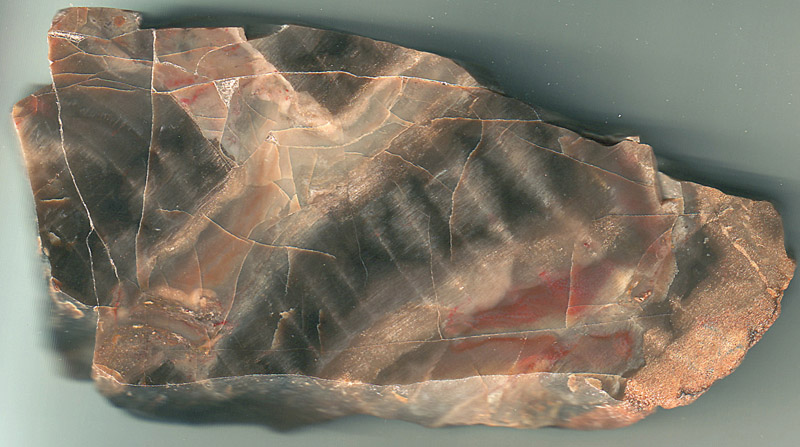What cracks can reveal about petrified
wood formation
Fragments of petrified
wood are so abundant in some places, as in some residential areas of
Chemnitz, that finds usually do not arouse scientific interest. The
lack of interest is also due to the fact that most of the finds are
irregular
fragments of "dull"
coniferous wood with well known tissue structure. Incidentally one of
such "dull" fragments, see image, has turned out highly interesting as
it shows three successive generations of cracks indicating distinctly
different
stages of silicification.
 - The first generation
of cracks is seen as thin parallel lines across the dark wood,
apparently caused by shrinkage of the tree trunk lying in sediment. The
bleached areas on either side of these cracks are probably due
to oxidation by atmospheric oxygen which had come in with entering
water and spread by diffusion.
- The first generation
of cracks is seen as thin parallel lines across the dark wood,
apparently caused by shrinkage of the tree trunk lying in sediment. The
bleached areas on either side of these cracks are probably due
to oxidation by atmospheric oxygen which had come in with entering
water and spread by diffusion.
- Cracks of the second generation are much bigger and of quite
different origin:
They are represented here by two wide cracks, one of them being a
split
along the wood as if from an axe blow, the other one a fracture gap of
one of the split-off parts broken across. Most probably they are due to
external causes. Obviously they had formed when the wood had not yet
been fully silicified since they had felt the
anisotropy of the wood: along and across the tree trunk. While
the trunk was lying in silica-rich water, the cracks got "healed",
which means the water inside gradually turned into hardening silica gel
and chalcedony, which had occured in the wood before.
- The cracks of a third generation are quite different from
those of the first and second ones:
Obviously their propagation had not been influenced by the anisotropy
of the wood, which means the wood with the previously formed cracks had
become thoroughly silicified meanwhile so that it behaved like an
isotropic material with cracks showing no preferred direction. These
latter cracks nearly disappear from sight when the polished face is
moistened but re-appear when drying.
Hence, they did not get healed but are still open. Some
of them make the surface of the fragment.
The
sample considered here visualises possible different stages in the
fossilisation of wood, which may promote understanding.
Sample: found in a line trench in front of St. Lucas
rectory, Chemnitz.
|

|
 42 42 |

 42
42 - The first generation
of cracks is seen as thin parallel lines across the dark wood,
apparently caused by shrinkage of the tree trunk lying in sediment. The
bleached areas on either side of these cracks are probably due
to oxidation by atmospheric oxygen which had come in with entering
water and spread by diffusion.
- The first generation
of cracks is seen as thin parallel lines across the dark wood,
apparently caused by shrinkage of the tree trunk lying in sediment. The
bleached areas on either side of these cracks are probably due
to oxidation by atmospheric oxygen which had come in with entering
water and spread by diffusion.
 42
42